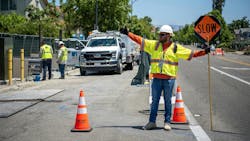Standing Between a Close Call and Catastrophe
By Cornelius Morgan, Contributing Author
A safe work zone creates a foundation for a productive, efficient and respected operation. In high-risk areas, the right personal protective equipment (PPE)—especially helmets—can mean the difference between a close call and a catastrophe. Strong leadership means making safety non-negotiable.
Federal and state agencies strictly enforce PPE requirements. The Occupational Safety and Health Administration’s (OSHA) standard 29 CFR 1910.135 mandates the use of protective helmets in areas where head injuries are possible, while 29 CFR 1926.95 requires workers to wear high-visibility clothing in roadway work zones.
When PPE isn’t taken seriously, the risks add up fast—hefty fines, project setbacks and accidents that never should have happened.
Construction’s Fatal Four
In road construction, danger comes from all directions—traffic, heavy equipment, falling debris and even the weather can turn a routine day into a life-threatening situation. OSHA data shows that most construction zone injuries come from major risks known as the Fatal Four: workers being struck by vehicles or equipment, dangerous falls, electrocution hazards and workers being caught-in or-between objects.
Every construction worker faces risks, but with the right PPE—hard hats, high-vis vests, and more—those threats are made more manageable.
Heads-Up on Helmets
A helmet doesn’t just protect a worker’s head. It also protects their future—because even one impact can change everything. For road construction managers meanwhile, helmets aren’t just a rule, they’re a responsibility.
For starters, not all helmets offer the same level of protection. To keep workers safe, they need to meet OSHA and American National Standards Institute (ANSI) standards for impact, penetration and electrical hazards.
Helmet technology has improved a lot over the years. They now absorb impact more effectively, stay in place better with enhanced chin straps, and often include face shields and hearing protection.
Of course, the best gear only works if it’s in top condition too. A damaged helmet won’t do its job. Workers should take a moment at the start and end of each shift to inspect their helmet. If it’s damaged, don’t take chances—replace it.
A bright helmet can also be the difference between being seen and being overlooked. High-visibility colors—fluorescent yellows, oranges and greens—pop in daylight while reflective tape or LED strips shine out when the sun goes down.
And remember that a poorly worn helmet is almost as bad as not wearing one at all. That’s why managers must prioritize proper training, enforcement and top-quality protective equipment.
High-Vis Vests
Modern high-vis vests are also tougher, smarter and more comfortable than ever. Newer designs use breathable mesh to prevent overheating, moisture-wicking materials for comfort and heavy-duty stitching for durability. Advanced models even add LED lighting.
Smart safety vests meanwhile are giving workers an extra set of eyes with GPS tracking and built-in proximity sensors that send alerts when they’re approaching hazardous zones or moving equipment.
Today’s vests also do more than make workers stand out—smart, functional features like breakaway panels to prevent entanglement and storage pockets for easy tool access are available.
Extra PPE
High-vis gear and helmets are essential, but they don’t cover every risk. Depending on the job, other PPE can be just as crucial. Where cutting, grinding or concrete work kicks up debris, dust and chemicals, safety goggles and face shields are a must.
Masks or respirators meanwhile should be considered for work zones where the accumulation of fumes or hazardous particles is a concern, such as a repaving project in the heart of a major metropolis.
It Starts with You
Safety starts with the right gear and the right policies reinforced by leadership. Decision-makers should implement PPE best practices that keep job sites running smoothly. Because at the end of the day, the most important thing is that every crew member makes it home.
Let’s make PPE non-negotiable in work zones.
Cornelius Morgan is the Sr. Director of EHS North America at AWP Safety, where he champions environmental health and safety initiatives across the organization.
